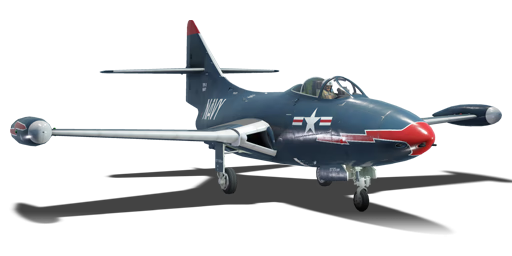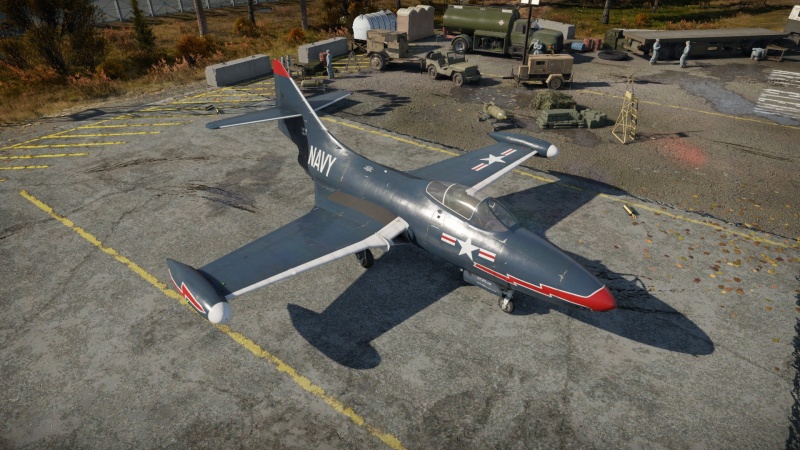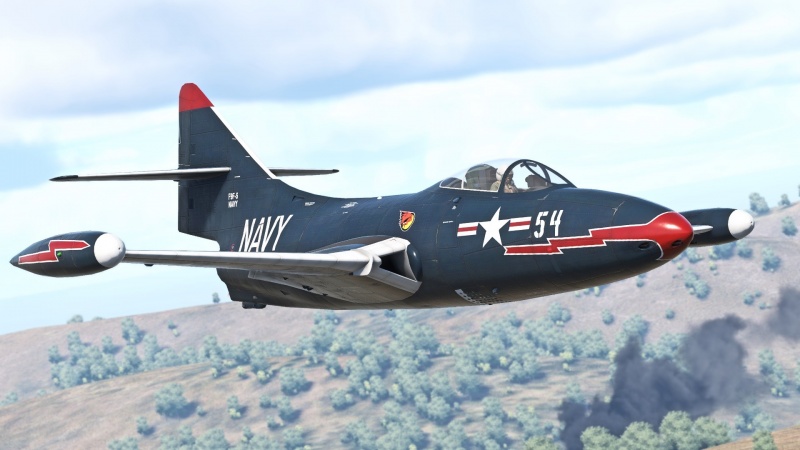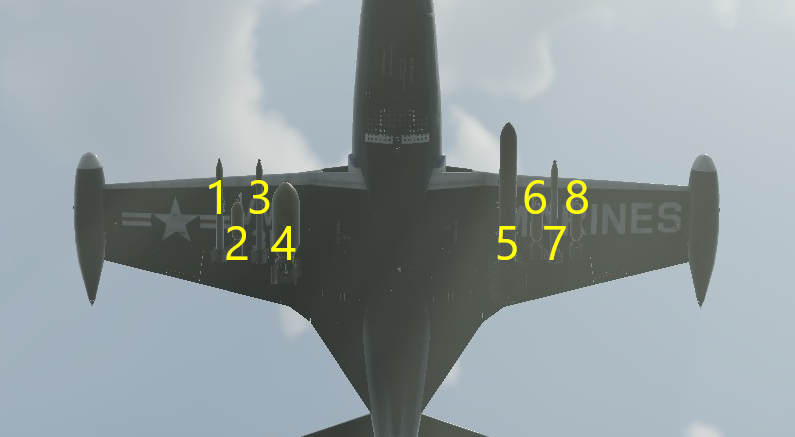Difference between revisions of "F9F-5"
(Updated description to new format) |
(→Description) |
||
| Line 14: | Line 14: | ||
The F9F-5 was a significant improvement over the F9F-4. It had substantial airframe changes over the F9F-4 such as a longer fuselage. More importantly, it had the Pratt & Whitney J48 turbojet which produces over 3,000 kgf. Over 600 F9F-5s were delivered to Naval squadrons and would end up serving in the Korean War. The F9F-5 was also used by the Blue Angels flight team until they were replaced by the F9F-8 Cougar in 1954. In 1962, F9F-5s would end up being redesignated as either target drones or drone directors until their final retirement a few years later. | The F9F-5 was a significant improvement over the F9F-4. It had substantial airframe changes over the F9F-4 such as a longer fuselage. More importantly, it had the Pratt & Whitney J48 turbojet which produces over 3,000 kgf. Over 600 F9F-5s were delivered to Naval squadrons and would end up serving in the Korean War. The F9F-5 was also used by the Blue Angels flight team until they were replaced by the F9F-8 Cougar in 1954. In 1962, F9F-5s would end up being redesignated as either target drones or drone directors until their final retirement a few years later. | ||
| − | Introduced in [[Update 1.33]], the '''{{Specs|name}}''' is a decent aircraft. Players can use it as a fighter-bomber thanks to its decent flight characteristics and expansive bomb loadouts. It has the standard Panther gun loadout of four chin-mounted 20 mm cannons which are quite deadly with the air target belt. The F9F-5 is commonly outclassed by other fighters so players should not be hyper-aggressive and stick to supporting teammates. In a | + | Introduced in [[Update 1.33]], the '''{{Specs|name}}''' is a decent aircraft. Players can use it as a fighter-bomber thanks to its decent flight characteristics and expansive bomb loadouts. It has the standard Panther gun loadout of four chin-mounted 20 mm cannons which are quite deadly with the air target belt. The F9F-5 is commonly outclassed by other fighters so players should not be hyper-aggressive and stick to supporting teammates. In a pinch, the F9F-5 can turn quite well which unfortunately comes at the cost of heavily draining energy. Nonetheless, the F9F-5 is sufficient in its role of fighting enemy aircraft; as well as bombing ground targets like tanks and pillboxes. |
== General info == | == General info == | ||
Revision as of 09:57, 20 September 2023
| This page is about the American naval jet fighter F9F-5. For other versions, see F9F (Family). |
Contents
Description
The F9F-5 was a significant improvement over the F9F-4. It had substantial airframe changes over the F9F-4 such as a longer fuselage. More importantly, it had the Pratt & Whitney J48 turbojet which produces over 3,000 kgf. Over 600 F9F-5s were delivered to Naval squadrons and would end up serving in the Korean War. The F9F-5 was also used by the Blue Angels flight team until they were replaced by the F9F-8 Cougar in 1954. In 1962, F9F-5s would end up being redesignated as either target drones or drone directors until their final retirement a few years later.
Introduced in Update 1.33, the F9F-5 Panther is a decent aircraft. Players can use it as a fighter-bomber thanks to its decent flight characteristics and expansive bomb loadouts. It has the standard Panther gun loadout of four chin-mounted 20 mm cannons which are quite deadly with the air target belt. The F9F-5 is commonly outclassed by other fighters so players should not be hyper-aggressive and stick to supporting teammates. In a pinch, the F9F-5 can turn quite well which unfortunately comes at the cost of heavily draining energy. Nonetheless, the F9F-5 is sufficient in its role of fighting enemy aircraft; as well as bombing ground targets like tanks and pillboxes.
General info
Flight performance
| Characteristics | Max Speed (km/h at 0 m - sea level) |
Max altitude (metres) |
Turn time (seconds) |
Rate of climb (metres/second) |
Take-off run (metres) | |||
|---|---|---|---|---|---|---|---|---|
| AB | RB | AB | RB | AB | RB | |||
| Stock | 958 | 948 | 12500 | 27.8 | 28.8 | 18.1 | 16.6 | 800 |
| Upgraded | 984 | 972 | 26.8 | 27.0 | 31.5 | 24.4 | ||
Details
| Features | |||||
|---|---|---|---|---|---|
| Combat flaps | Take-off flaps | Landing flaps | Air brakes | Arrestor gear | Drogue chute |
| ✓ | ✓ | ✓ | ✓ | ✓ | X |
| Limits | ||||||
|---|---|---|---|---|---|---|
| Wings (km/h) | Gear (km/h) | Flaps (km/h) | Max Static G | |||
| Combat | Take-off | Landing | + | - | ||
| 1000 | 410 | 581 | 548 | 381 | ~8 | ~3 |
| Optimal velocities (km/h) | |||
|---|---|---|---|
| Ailerons | Rudder | Elevators | Radiator |
| < 620 | < 650 | < 720 | N/A |
Engine performance
| Engine | Aircraft mass | |||||||
|---|---|---|---|---|---|---|---|---|
| Engine name | Number | Basic mass | Wing loading (full fuel) | |||||
| Pratt & Whitney J-48-P-6 | 1 | 5,225 kg | 352 kg/m2 | |||||
| Engine characteristics | Mass with fuel (no weapons load) | Max Takeoff Weight | ||||||
| Weight (each) | Type | 20m fuel | 30m fuel | 45m fuel | 60m fuel | 68m fuel | ||
| 952 kg | Centrifugal-flow turbojet | 6,112 kg | 6,522 kg | 7,171 kg | 7,819 kg | 8,183 kg | 9,636 kg | |
| Maximum engine thrust @ 0 m (RB/SB) | Thrust to weight ratio @ 0 m (WEP) | |||||||
| Condition | 100% | WEP | 20m fuel | 30m fuel | 45m fuel | 60m fuel | 68m fuel | MTOW |
| Stationary | 2,730 kgf | 3,085 kgf | 0.50 | 0.47 | 0.43 | 0.39 | 0.38 | 0.32 |
| Optimal | 2,730 kgf (0 km/h) |
3,085 kgf (0 km/h) |
0.50 | 0.47 | 0.43 | 0.39 | 0.38 | 0.32 |
Survivability and armour
- 9.5 mm steel - in front of the cockpit
- 8.5 mm steel - behind the pilot
- 60 mm steel - armoured windscreen
Modifications and economy
The primary modifications that will need to be unlocked are flight performance, handling (New boosters), and Offensive 20 mm belts. After unlocking these high priority improvements, then the focus is secondary weaponry. Without the New 20 mm cannon modification the plane tends to have a high spread when firing its primary armament.
Armaments
Offensive armament
The F9F-5 is armed with:
- 4 x 20 mm M3 cannons, nose-mounted (190 rpg = 760 total)
Suspended armament
The F9F-5 can be outfitted with the following ordnance:
| 1 | 2 | 3 | 4 | 5 | 6 | 7 | 8 | ||
|---|---|---|---|---|---|---|---|---|---|
| 100 lb AN-M30A1 bombs | 1* | 1 | 1 | 1 | 1 | 1 | 1 | 1* | |
| 250 lb AN-M57 bombs | 1* | 1 | 1 | 1 | 1 | 1 | 1 | 1* | |
| 500 lb AN-M64A1 bombs | 1* | 1 | 1 | 1 | 1 | 1* | |||
| 1,000 lb AN-M65A1 bombs | 1 | 1 | |||||||
| HVAR rockets | 1* | 1 | 1 | 1 | 1 | 1* | |||
| Maximum permissible loadout weight: 1,460 kg Maximum permissible wing load: 730 kg Maximum permissible weight imbalance: 450 kg | |||||||||
| * 500 lb bombs on hardpoints 2/7 cannot be equipped with ordnance on hardpoints 1/8 | |||||||||
| Default weapon presets | |
|---|---|
| |
Usage in battles
- Arcade Battles
The baseline Panther has very poor performance, losing a lot of speed in turns and having poor acceleration. Once the aircraft has been upgraded, it is a very powerful fighter. Its decent climb rate and 20mm guns make the aircraft best for Boom and Zoom tactics. The aircraft has poor top speed, making it vulnerable to enemy F-86s and MiGs flying at higher altitudes.
- Realistic and Simulator Battles
The Panther will typically find itself outclassed. However, it does excel in a support fighter role. Distracted opponents are easy prey when the Panther's high-speed diving and manoeuvrability are applied correctly. When engaged 1 on 1 with other jet fighters, its flaws (low top speed) can be exposed. Defensively, the Panther has an uncanny ability to escape pursuing enemies when using its agility to your advantage. The Panther greatly excels at the Fighter-bomber role due to its optional payloads.
Radars
The F9F-5 is equipped with an AN/APG-30 rangefinding radar, located in the nose of the aircraft. It will automatically detect other planes within the scanning area and display the range to the closest target. It is linked with a gyro gunsight and can help with aiming at close range.
| AN/APG-30 - Rangefinding radar | |||
|---|---|---|---|
| Maximum Tracking Range |
Minimum Tracking Range |
Azimuth Tracking Angle |
Elevation Tracking Angle |
| 2,750 m | 300 m | ±9° | ±9° |
Pros and cons
Pros:
- Good manoeuvrability at higher speeds
- Excellent roll rate
- Decent low-altitude performance
- Powerful armament with a high rate of fire
- Large maximum fuel capacity
Cons:
- Poor high-altitude performance
- Poor low-speed manoeuvrability
- Poor top speed
History
The F9F Panther was a fighter-bomber developed by the Grumman Aircraft Engineering Corporation and used during the Korean War by the US Navy and USMC. It was also the first aircraft used by the Navy's Blue Angels aerial demonstration team.
The project started after World War II when Grumman proposed the XF9F-1 experimental aircraft (Grumman designation G75), a two-seat, four-engined (to make up for the low power output of early turbojets) aircraft for a contract to build a jet-powered carrier-based night fighter for the US Navy. The company lost to the Douglas XF3D-1, but received funding to continue development of the XF9F. After jet technologies evolved to create engines with higher thrust, Grumman designed the Model G79, a single-engined day fighter. When the Navy realized the potential of this new design, they shifted funding towards the G79, which became the F9F Panther. Permanent fuel tanks were added to the wingtips to extend the range of the thirsty jet, but the added weight incidentally improved the aircraft's roll rate.
The F9F-5 is the last and most produced variant of the Panther. It is a further development of the F9F-4, which lengthened the fuselage to carry more fuel. The F9F-5 was re-engined with the Pratt & Whitney J48 engine, a license-built version of the Rolls-Royce Tay engine. The Panther was later developed into the F9 Cougar, a swept-wing aircraft with significantly more thrust.
Media
- Skins
See also
- Related development
External links
| Grumman Aircraft Engineering Corporation | |
|---|---|
| Aircraft | |
| Fighters | |
| F3F | F3F-2 · Galer's F3F-2 |
| F4F Wildcat | F4F-3 · F4F-4 |
| XF5F Skyrocket | XF5F · XP-50 |
| F6F Hellcat | F6F-5 · F6F-5N |
| F7F Tigercat | F7F-1 · F7F-3 |
| F8F Bearcat | F8F-1 · F8F-1B |
| Jet Fighters | |
| F9F Panther/Cougar | F9F-2 · F9F-5 · F9F-8 |
| F-11 Tiger | F11F-1 |
| F-14 Tomcat | F-14A Early · F-14B |
| Jet Strike Aircraft | |
| A-6 Intruder | A-6E TRAM |
| Bombers | TBF-1C |
| Export | ▄Martlet Mk IV · ▄F6F-5 · ▄F6F-5N · ▄F8F-1B · ▄Avenger Mk II · ▄Hellcat Mk II |
| ▄F-14A IRIAF | |
| Naval Vehicles | |
| Patrol Gunboat Hydrofoil (PGH) | USS Flagstaff |
| USA jet aircraft | |
|---|---|
| Fighters | |
| F9F | F9F-2 · F9F-5 · F9F-8 |
| F-80 | F-80A-5 · F-80C-10 |
| F-84 | F-84B-26 · F-84F · F-84G-21-RE |
| F-86 | F-86A-5 · F-86F-25 · F-86F-2 · F-86F-35 |
| F-89 | F-89B · F-89D |
| F-100 | F-100D |
| F-104 | F-104A · F-104C |
| F-4 | F-4C Phantom II · F-4E Phantom II · F-4J Phantom II · F-4S Phantom II |
| F-5 | F-5A · F-5C · F-5E · F-20A |
| F-8 | F8U-2 · F-8E |
| F-14 | F-14A Early · ▄F-14A IRIAF · F-14B |
| F-15 | F-15A · F-15C MSIP II · F-15E |
| F-16 | F-16A · F-16A ADF · F-16C |
| Other | P-59A · F2H-2 · F3D-1 · F3H-2 · F4D-1 · F11F-1 |
| Strike Aircraft | |
| FJ-4 | FJ-4B · FJ-4B VMF-232 |
| A-4 | A-4B · A-4E Early |
| A-7 | A-7D · A-7E · A-7K |
| AV-8 | AV-8A · AV-8C · AV-8B Plus · AV-8B (NA) |
| A-10 | A-10A · A-10A Late · A-10C |
| F-111 | F-111A · F-111F |
| Other | A-6E TRAM · F-105D · F-117 |
| Bombers | |
| B-57 | B-57A · B-57B |







